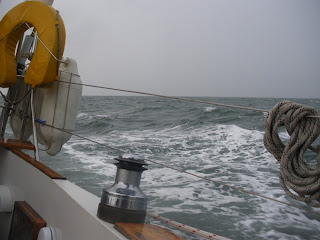 A quiet day in Burnham on Crouch. The yacht harbour marina is huge and generally well organised, the only disappointment being that the showers ran cold.
A quiet day in Burnham on Crouch. The yacht harbour marina is huge and generally well organised, the only disappointment being that the showers ran cold.After a porridge breakfast, hosing down the boat, fixing the anchor pin, filling the water bottles, doing the engine checks, passage planning for tomorrow and generally tidying up ... we walked the 15 minutes from the yacht harbour into Burnham. Lunch in the Royal Burnham Yacht Club gave us a splendid view of the wide river and the many boats sailing to and fro. There happened to be an 'Art Trail' this w/e, so when we came across them we inspected and critiqued various paintings. We even found a tiny charity shop that was open. Then a light food shop for the last 3 days, ice creams to celebrate the very sunny (and windy) day, and back to the boat for some serious lazing.
Reading the Sunday paper caught us up on Wimbledon at least - we need to know a bit about the women as we have tickets for the women's final on Centre Court next Saturday. On other news, well there didn't seem to be much - summer must be here.
As we near home the Moitessier effect is setting in a little bit. Bernard Moitessier was in the first single-handed, non-stop, sailing race around the globe in 1968, and instead of finishing he just kept sailing and went half-way round the world again before stopping at Tahiti. Other long distance sailors, notably Ellen MacArthur, have talked about wanting to just keep sailing rather than re-enter society. Not that we are in that league of course ... it's just that a tiny voice is whispering "why not turn left and just keep going!". We won't of course - work, friends and home are calling us back to real life.












































